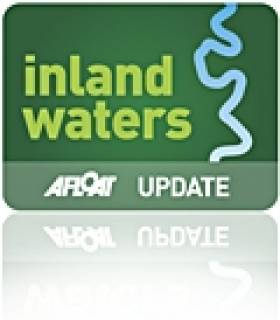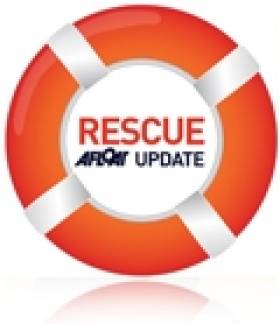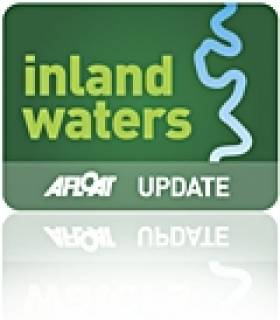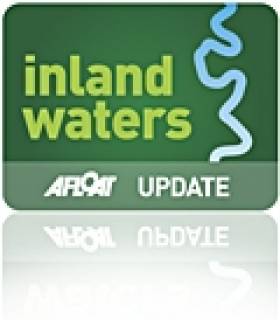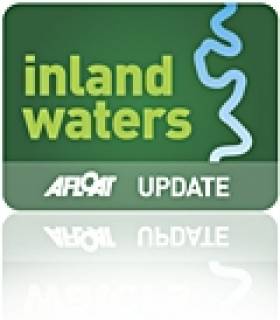Displaying items by tag: inland waterways
#INLAND WATERWAYS - Waterways Ireland has been advised by ESB Energy International that Ardnacrusha Lock is now fully pre-booked over the following periods:
Between midday on Friday 29 June and dusk on Sunday 1 July; and Between midday on Friday 6 July and dusk on Sunday 8 July.
This is to facilitate boats attending the Limerick/Shannon Estuary Rally.
Boat users that are planning to navigate between Limerick and Killaloe in late June early July should schedule passage through Ardnacrusha Lock outside of the periods listed above.
#INLAND WATERWAYS - The "main thrust" of waterways refurbishment is still focused on the re-opening of the Ulster Canal from Lough Erne to Clones, according to the Minister for Arts, Heritage and the Gaeltacht.
Responding in writing to a Dáil question from Kildare South TD Jack Wall regarding plans for the development of Ireland's canal system under Waterways Ireland, Minister Jimmy Deenihan confirmed that the Ulster Canal Project is still top priority - despite the Government's U-turn on its commitment to cover the full capital costs of the scheme, as previously reported on Afloat.ie.
The minister commented: "Since its formation in 1999, Waterways Ireland has continued to upgrade the facilities on the canals through the capital allocations under the National Development Plans. The canals system has benefited extremely well during that time, particularly with the number of additional mooring and landing spaces that have been made available. The provision of further mooring space will be dependent on available finance and priorities over the coming years."
Minister Deenihan said his department's capital allocation for Waterways Ireland is €4.5 million which "will facilitate continued investment in the development and restoration of the inland waterways".
He added that Waterways Ireland is also "undertaking feasibility studies on the Kilbeggan Branch of the Grand Canal and on the Longford Branch of the Royal Canal" which are due to be completed by the end of 2013.
With reference to staffing levels among lock keepers, the minister said: "I am informed by Waterways Ireland that there are 20 lock keepers employed at present on the Grand Canal and Barrow Navigation. A number of staff have retired recently and decisions on their replacement will be taken having regard to the business needs of the organisation.
"I understand that Waterways Ireland is not planning to recruit lock keepers at this time. Any posts filled will be either by internal transfer or external recruitment, depending on the particular circumstances."
The minister also commented on waterways traffic, noting that boat traffic numbers "have remained fairly constant over 2009 and 2010" and that in 2011 "numbers increased by 30% following the re-opening of the Royal Canal".
In addition, he emphasised "the fact that access was available to the Tall Ships event in Waterford".
Inland Fisheries Ireland Looking For Seasonal Fishery Officers
#JOBS AND CAREERS - Inland Fisheries Ireland (IFI) is seeking to recruit a number of staff as Fishery Officers nationwide for a maximum period of four months during 2012 and will shortly commence a process to fill these positions.
The Fishery Officer will be primarily concerned with the implementation and enforcement of the provision of the Fisheries Acts, Water Pollution Acts and other relevant statutory provisions.
He or she is required to provide, in co-operation with other fisheries staff, comprehensive conservation and protection services, as well as improvement, development and fisheries management support services, both inland and at sea, within any part of a fisheries district and/or any other area assigned within one or more fisheries districts.
The Fishery Officer is also expected to assist either directly or indirectly in fisheries-related research projects.
Salary at the first point of the Fishery Officer Scale is €22,349 plus an Unsocial Hours allowance, which will be paid at either 50% or 100% relative to the number of unsocial hours worked.
Applications should be mailed for the attention of Ms Sandra Doyle, REF: HR/FO/2012, Inland Fisheries Ireland, Swords Business Campus, Swords, Co. Dublin or by e-mail to [email protected] by the close of business on Tuesday 24 April 2012.
For further job details contact Sandra Doyle at 01 8842 612. Please note that late applications will not be processed.
Trial Dredging to Help Rid Barrow of Invasive Asian Clam
#INLAND WATERWAYS - Trial dredging operations to curtail the spread of Asian clams at designated sites in the lower River Barrow are set to conclude today.
Inland Fisheries Ireland (IFI) employed the use of a a traditional cockle harvesting boat to physically remove the clams from the river bed, in an effort to explore methods of controlling or eradicating what it describes as an "ecosystem-changing invader" in other infested waters.
IFI scientists supervised the trials, using teams of divers to quantify the result of the dredging efforts.
The Asian clam (Corbicula fluminea) is "a most unwelcome addition to the fauna of the lower River Barrow". The bivalve mollusc is regarded as "one of the most notorious aquatic invasive species in the world".
First recorded in the river downstream of St Mullin’s in April 2010, subsequent IFI studies have revealed that the Asian clam is firmly established in the lower Barrow and in the River Nore downstream of Inistioge. Populations have also been recorded in the River Shannon and in Lough Derg.
In one section of the River Barrow the clam has achieved a "staggering" density of almost 10,000 per square metre.
Dr Joe Caffrey, senior scientist with IFI, said of the trial dregding: “It is imperative that every effort is made to control the expansion and spread of this highly adept invasive species.
"The results from these trials will inform future national management plans for this most unwelcome non-native species and will, at the very least, dramatically reduce the numbers of individuals in the test sites.
He added: "In tandem with these trials, research effort is being focused at producing other control methods that can be targeted as this species.”
Second Cruiser in a Week Runs Aground in Lough Erne
#RESCUE - Four people were rescued on Lough Erne yesterday after their motor cruiser ran aground in the second such incident in a week, the Belfast Telegraph reports.
All on board were retrieved by RNLI lifeboat from the 29ft cruiser, which is believed to have stranded on rocks beyond the marked channel of the lough.
No injuries or damage to the vessel were reported, with a Northern Ireland Coastguard spokesperson describing it as "a routine rescue".
The coastguard blamed low water levels in the lough caused by lack of rainfall in Co Fermanagh.
Waterways Ireland has posted a marine notice warning boat users of the risks posed by "the extended period of unseasonal dry weather" for Ireland's inland waterways.
In a similar incident last Friday, three adults and two children were rescued from a cruiser that stranded in shallow water on the lough.
The Belfast Telegraph has more on the story HERE.
New Warning on Low Water Levels
Waterways Ireland is advising navigation users that the extended period of unseasonal dry weather has meant that water levels in the navigations are presently lower than normal for this time of year. A Marine Notice has been issued and can be found on www.waterwaysireland.org. An additional Marine Notice has also been issued for the closure of the 34th and 35th levels of the Royal Canal due to for repairs and the summit level due to low water levels.
As the boating season is about to get underway masters and users are advised of the implications of continuing dry weather on water levels. If water levels fall below normal summer levels, masters should be aware that their vessels may be at risk of grounding, particularly deep drafted vessels. Where possible masters should navigate on or near the centreline of the channel and also avoid short cutting in dog-legged channels and navigating too close to navigation markers.
Proceeding at a slow speed will also reduce "squat" effect i.e. where the vessel tends to sit lower in the water as a consequence of higher speed.
Low water levels will also impact on slipways with reduced slipway length available under the water surface and the possibility of launching trailers dropping off the end of the concrete apron onto the river /lake bed and causing damage to trailer, outboard motor or boat. More slipway surface will also be susceptible to weed growth requiring care while engaged in launching boats.
In the interests of reducing potential water loss, users passing through locks are requested to maximise on the number of vessels in a lock. Please be patient and wait for other boaters to share the lock with you rather than using locks for sole passages. In addition, if possible make sure lock cycles are used for vessels travelling each way. Each lock cycle should take boats both up and down stream. Shut all sluice gates and paddles when leaving a lock.
Very dry riverbanks are more susceptible to erosion from vessel wash. Please ensure you adhere to the speed limits and maintain a reduced wash. Users are also requested not to leave taps running at watering points or service blocks in the interest of water conservation.
More information may be sought from the Inspector of Navigation Tel: 00 353 (0)90 6494232.
Waterways Ireland Issues Notice on Low Water Levels
Waterways Ireland has issued a notice to boaters on all navigations about low water levels. The extended period of unseasonal dry weather has meant that water levels in the navigations are presently lower than normal for this time of year. As the boating season is about to get underway users are advised of the following:
Navigation
If the dry weather continues and water levels fall below normal summer levels masters should be aware that their vessels may be at risk of grounding, particularly deep drafted vessels.
To reduce this risk masters should navigate where possible on or near the centreline of the channel and also avoid short cutting in dog-legged channels and navigating too close to navigation markers.
Proceeding at a slow speed will also reduce "squat" effect i.e. where the vessel tends to sit lower in the water as a consequence of higher speed.
Slipways
Low water levels will also impact on slipways with reduced slipway length available under the water surface and the possibility of launching trailers dropping off the end of the concrete apron onto the river /lake bed and causing damage to trailer, outboard motor or boat. More slipway surface will also be susceptible to weed growth requiring care while engaged in launching boats.
Bank Erosion
Very dry riverbanks are more susceptible to erosion from vessel wash. Please ensure you adhere to the speed limits and maintain a reduced wash.
Lock Share
Where appropriate by maximising on the number of vessels in a lock the total volume of water moving downstream is decreased. This also reduces the volume of water used. Please be patient and wait for other boaters to share the lock with you rather than using locks for sole passages.
Efficient Lock Use
Make sure lock cycles are used for vessels travelling each way. Each lock cycle should take boats both up and down stream. Shut all sluice gates and paddles when leaving a lock.
Service Blocks
You are requested not to leave taps running at watering points or service blocks in the interest of water conservation.
River Barrow Features on Sky's 'Distance Shores' TV Series
The River Barrow, Graignamanagh, St. Mullins and a boat trip from New Ross to Hook Head features on the new series of Distant Shores, a sailing adventure TV series where an American couple Paul and Sheryl Shard undertake different voyages.
In season eight the filmakers start from north England and sail to Ireland. At New Ross they are befriended by local boaters and enjoy a day trip on the Barrow. Then they have some good “craic” at the boat club! The series was filmed last May and is on the new schedule from Travel Channel (Sky channel 251).
The new Season (8 episodes) of Distant Shores air on Wednesday, April 4 at 1930. The first episode features New Ross and the River Barrow. It repeats on Thurs Apr 5 at 1330,
A search and recovery operation is underway upstream of the Carrick-on-Shannon town bridge for a distance of approximately 400m. The Garda Water Unit has divers in the water and both Garda and Civil Defence vessels are searching this area. Waterways Ireland has advised boats in the area to approach this area at slow speed and note any directions or instructions issued by the Garda or Civil Defence.
Survey to Assess Value of Irish Angling
#ANGLING - Inland Fisheries Ireland (IFI) has appointed Tourism Development International (TDI) to undertake a Socio-Economic Survey of Recreational Angling in Ireland.
The overall objective of the survey, which will run over the course of 2012, is to establish the current volume and value of domestic and overseas recreational angling in the country.
Pike, coarse fish, bass, salmon, sea trout, brown trout and sea anglers will all be invited to participate in what is described as Ireland's most comprehensive angling survey undertaken in decades.
The survey will inform IFI and its tourism partners in relation to the business of angling in Ireland and also enable improved strategic planning and decision-making in terms of product development and marketing.
"Anglers are the key to this survey," commented Minister of State for Natural Resources Fergus O'Dowd. "They know the resource and they understand the importance of sustainability. What anglers contribute to Ireland’s economy is unknown but I am certain that it is significant.
"Angling takes place in every river and lake in Ireland and all around our coastline. There is no town or village in Ireland that doesn’t have anglers."
He added: "It is imperative that the inland fisheries and sea angling resources are managed in the best way possible to ensure enjoyment for our local and visiting anglers, sustainable jobs in rural communities and maximising its potential to add to Ireland’s economy.
"Getting the right information from those most involved will greatly assist in improving the angling product."
The survey comprises two parts: a household survey and a survey of recreational anglers which will commence in April. Anglers will be met at fishing locations throughout Ireland and invited to participate there and then, or later by phone or online. IFI says that every effort will be made to accommodate participation.
- angling
- Inland Fisheries Ireland
- IFI
- Tourism Development International
- TDI
- survey
- SocioEconomic Survey of Recreational Angling in Ireland
- Pike
- Salmon
- Sea Trout
- brown trout
- coarse angling
- sea angling
- tourism
- business
- marketing
- development
- Minister of State for Natural Resources
- Fergus O'Dowd
- sustainability
- inland waterways
- jobs



























